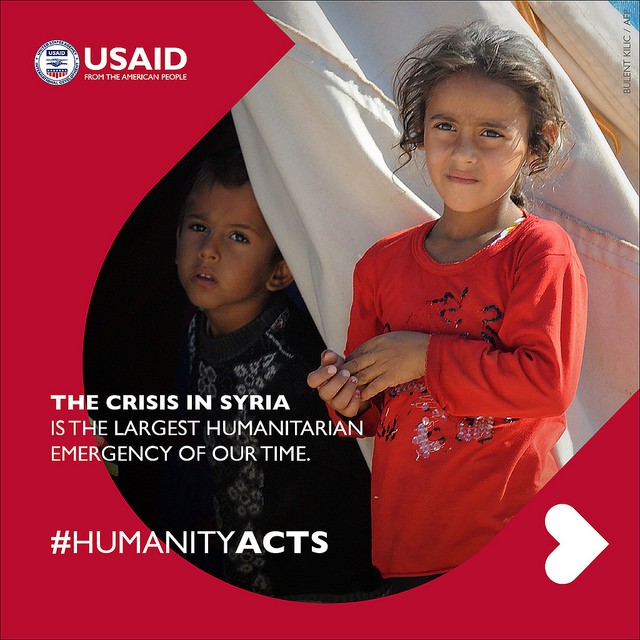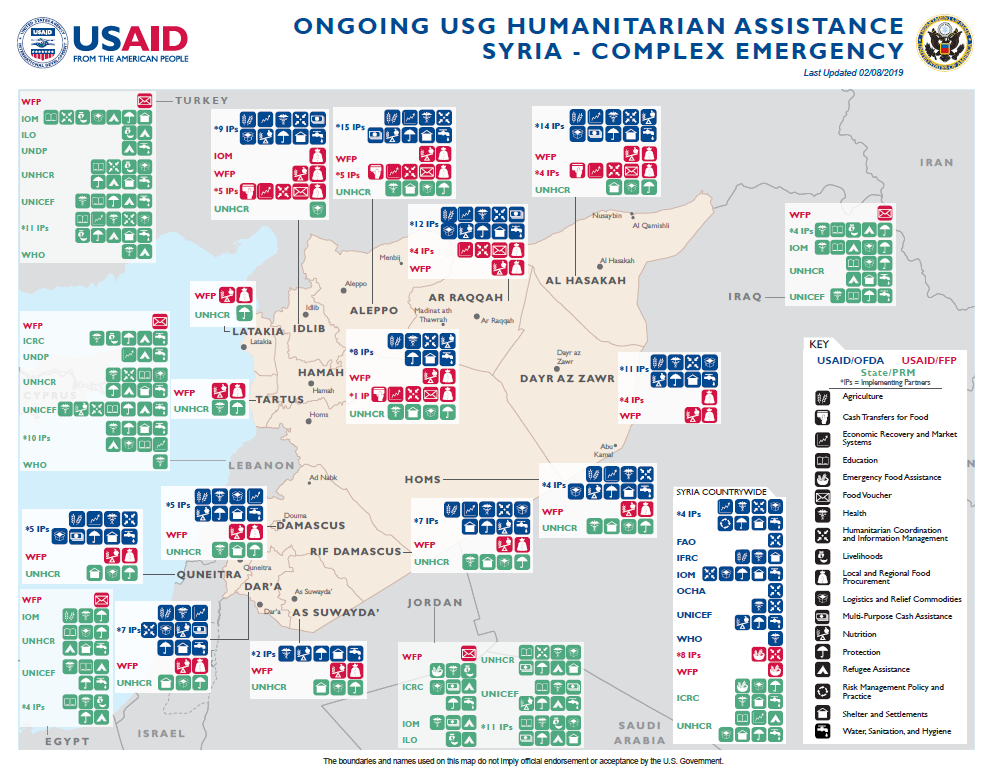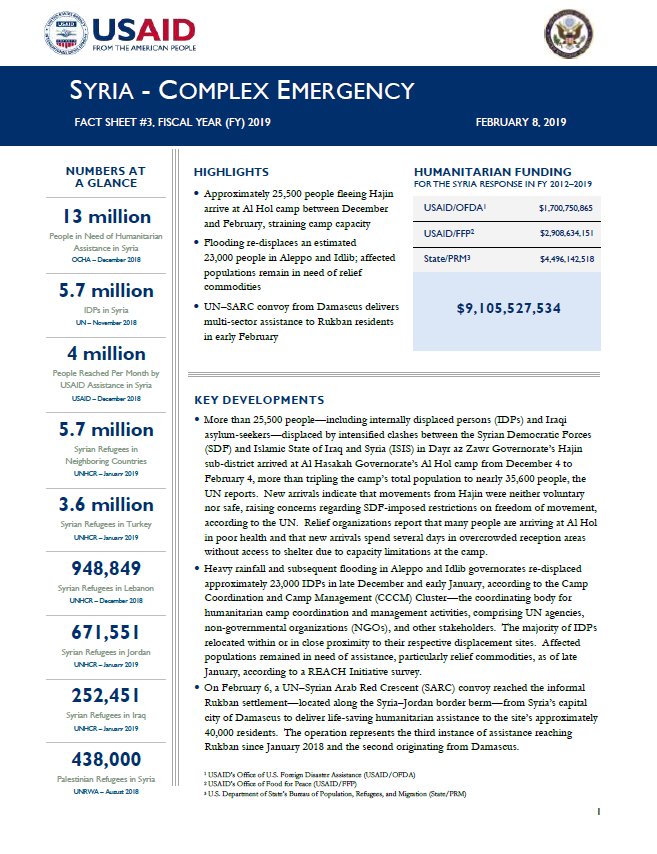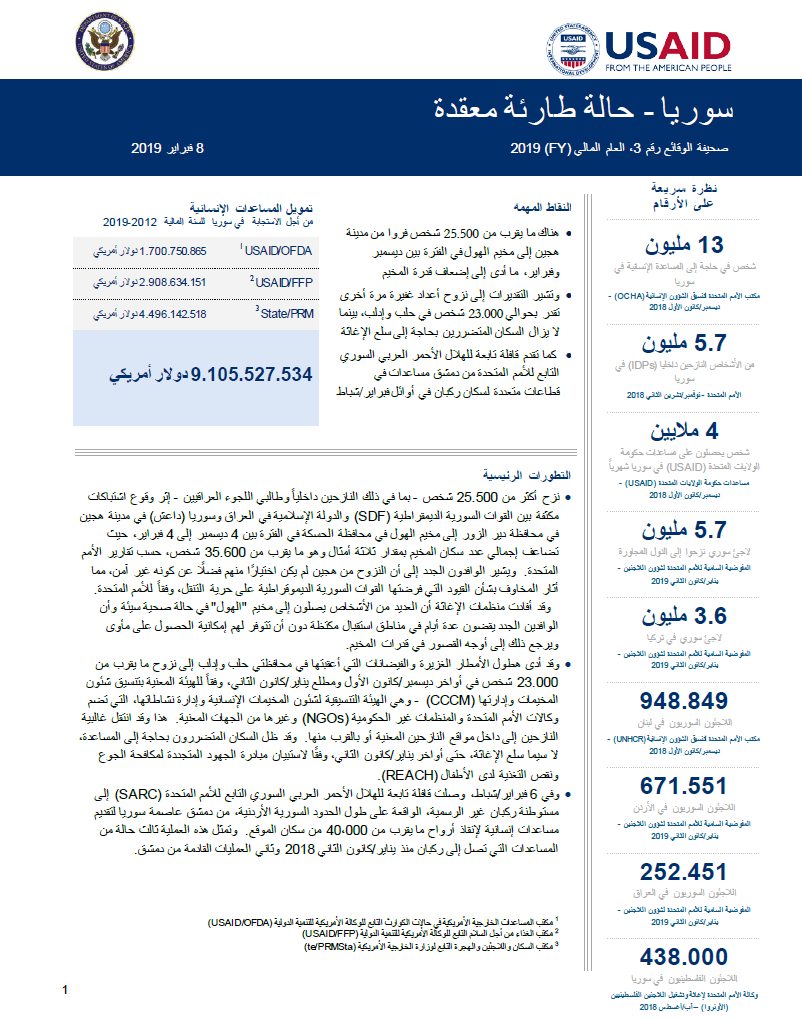- What We Do
- Agriculture and Food Security
- Democracy, Human Rights and Governance
- Economic Growth and Trade
- Education
- Environment and Global Climate Change
- Gender Equality and Women's Empowerment
- Global Health
- Humanitarian Assistance
- Transformation at USAID
- Water and Sanitation
- Working in Crises and Conflict
- U.S. Global Development Lab
Speeches Shim
February 08, 2019
Highlights
Approximately 25,500 people fleeing Hajin arrive at Al Hol camp between December and February, straining camp capacity
Flooding re-displaces an estimated 23,000 people in Aleppo and Idlib; affected populations remain in need of relief commodities
UN–SARC convoy from Damascus delivers multi-sector assistance to Rukban residents in early February
Key Developments
More than 25,500 people—including internally displaced persons (IDPs) and Iraqi asylum-seekers—displaced by intensified clashes between the Syrian Democratic Forces (SDF) and Islamic State of Iraq and Syria (ISIS) in Dayr az Zawr Governorate’s Hajin sub-district arrived at Al Hasakah Governorate’s Al Hol camp from December 4 to February 4, more than tripling the camp’s total population to nearly 35,600 people, the UN reports. New arrivals indicate that movements from Hajin were neither voluntary nor safe, raising concerns regarding SDF-imposed restrictions on freedom of movement, according to the UN. Relief organizations report that many people are arriving at Al Hol in poor health and that new arrivals spend several days in overcrowded reception areas without access to shelter due to capacity limitations at the camp.
Heavy rainfall and subsequent flooding in Aleppo and Idlib governorates re-displaced approximately 23,000 IDPs in late December and early January, according to the Camp Coordination and Camp Management (CCCM) Cluster—the coordinating body for humanitarian camp coordination and management activities, comprising UN agencies, non-governmental organizations (NGOs), and other stakeholders. The majority of IDPs relocated within or in close proximity to their respective displacement sites. Affected populations remained in need of assistance, particularly relief commodities, as of late January, according to a REACH Initiative survey.
On February 6, a UN–Syrian Arab Red Crescent (SARC) convoy reached the informal Rukban settlement—located along the Syria–Jordan border berm—from Syria’s capital city of Damascus to deliver life-saving humanitarian assistance to the site’s approximately 40,000 residents. The operation represents the third instance of assistance reaching Rukban since January 2018 and the second originating from Damascus.
Syria Complex Emergency - Map #3 FY19 ![]() (pdf - 463k)
(pdf - 463k)
Numbers At A Glance
13 million
5.7 million
4 million
5.7 million
3.6 million
948,849
671,551
252,451
438,000
Humanitarian Funding
To Syria Humanitarian Response
FY 2012 - FY 2018
| USAID/OFDA | $1,700,750,865 |
| USAID/FFP | $2,908,634,151 |
| State/PRM | $4,496,142,518 |
| TOTAL | $9,105,527,534 |
Syria Complex Emergency - Fact Sheet #3 FY19 ![]() (pdf - 207k)
(pdf - 207k)
INSECURITY, DISPLACEMENT, AND HUMANITARIAN ACCESS
Conflict in Syria killed at least 6,960 civilians from January–December 2018, of which at least 4,630 deaths were caused by Syrian Arab Republic Government (SARG) and Government of the Russian Federation military operations, according to the Syria Network for Human Rights. Rif Damascus Governorate accounted for the highest number of civilian deaths with approximately 2,090 fatalities, followed by Idlib and Aleppo with an estimated 1,670 and 770 civilian deaths, respectively.
The UN Security Council (UNSC) adopted UNSC Resolution 2449 on December 13, authorizing a one-year extension of cross-border humanitarian assistance into Syria until January 10, 2020. UNSC Resolution 2165, adopted in 2014, established the original mandate granting UN agencies humanitarian access into Syria through four approved border crossings with Iraq, Jordan, and Turkey; the UN has subsequently extended the resolution’s mandate on an annual basis. In addition to reauthorizing cross-border access to Syria, the UNSC implored all parties to the conflict to allow safe, unimpeded, and sustained access for UN humanitarian convoys and partners throughout Syria.
On December 9, the UN commenced a one-time shipment of approximately 11,200 metric tons of multi-sector assistance sufficient to support at least 650,000 people for one month from Jordan to Syria through the Nasib–Jaber border crossing. The operation represents the first UN humanitarian shipment from Jordan to Syria since late June, as well as the first use of the crossing for relief purposes; the crossing was closed in April 2015 and reopened for commercial purposes in October 2018. As of late December, the UN had transferred approximately 200 truckloads of relief commodities through the crossing, including 180 trucks carrying UN World Food Program (WFP)-supplied food assistance sufficient to feed approximately 543,000 people.
On February 6, a UN–SARC convoy from Damascus arrived at the informal Rukban settlement, transporting food, health, nutrition, and water, sanitation, and hygiene (WASH) supplies, as well as winterization items, sufficient for more than 41,000 people for one month, the UN reports. During the operation, relief organizations plan to vaccinate 10,000 children ages five years and younger and conduct an intention survey to inform options for safe, voluntary, and dignified relocations for Rukban residents.
Northeastern Syria
Approximately 25,500 people displaced by fighting between ISIS and SDF in Hajin arrived at Al Hol camp from December 4 to February 4, bringing the camp’s total population to nearly 35,600 people, the UN reports. SDF was reportedly directing displaced populations from Hajin to Al Hol camp, raising concerns among relief organizations of limited IDP freedom of movement, according to the Office of the UN High Commissioner for Refugees (UNHCR). Recent arrivals indicate that movements from Hajin were neither voluntary nor safe and noted a preference to reside with family and acquaintances in other parts of Dayr az Zawr, the UN reports. Conflict-related insecurity has also restricted relief agencies’ ability to provide assistance, including life-saving medical treatment, to people in transit from Hajin to Al Hol.
Insecurity also continues to hinder civilian movements and efforts to provide humanitarian assistance in Hajin and neighboring sub-districts of Basira, Sur, Susat, and Thiban, limiting populations’ access to basic services, such as health and sanitation facilitates. As of late January, between 2,000 and 4,000 people remained in Hajin and reported shortages of food and medical supplies and widespread infrastructure destruction, the UN reports.
Heavy rainfall and subsequent flooding in late November and early December affected more than 90 percent of the 9,600 people residing in Al Haskah’s Areesheh IDP camp, the UN reports. As of January, relief agencies had relocated approximately 6,000 people to safer areas in the camp and constructed large, communal tents in the event that further flooding displaces additional individuals, according to UNHCR.
Northwestern Syria
Heavy flooding between late December and early January destroyed nearly 7,000 shelters in approximately 180 assessed displacement sites throughout northern Aleppo and Idlib, prompting the displacement of an estimated 23,000 people, according to the CCCM Cluster and a REACH Initiative survey. The majority of IDPs relocated within or in close proximity to respective IDP sites, as well as in nearby schools. In response, cluster members initially distributed nearly 80 tents to affected households in early January. CCCM reception centers are also providing an estimated 2,000 IDPs with food, health, protection, shelter, and WASH assistance.
FOOD SECURITY AND NUTRITION
USAID/FFP partner WFP provided emergency food assistance to more than 3.6 million people across all 14 Syrian governorates in December, including nearly 369,000 people in 55 UN-designated hard-to-reach areas in Dayr az Zawr, Homs, Quneitra, Ar Raqqah, and Rif Damascus governorates. Additionally, WFP livelihood activities—including farming support, food processing, and vocational training—benefitted more than 134,000 people across 11 governorates from January–December 2018.
In January, WFP continued to provide emergency food assistance to all residents at Al Hol camp, including new arrivals, as well as preventative nutrition assistance to children younger than 12 months of age.
WFP provided nutrition supplies for the prevention of acute malnutrition for nearly 101,000 children in 13 governorates in December. WFP also delivered nutrition supplies for the treatment of moderate acute malnutrition to nutrition centers and mobile clinics in Rif Damascus, sufficient to treat nearly 580 individuals for one month. Additionally, approximately 37,800 pregnant and lactating women received WFP-provided cash-based transfers to purchase nutritious foods in Aleppo, Damascus, Hamah, Homs, Latakia, Rif Damascus, and Tartus governorates during the month.
With support from USAID and other donors, the UN Children’s Fund (UNICEF) screened more than 121,000 children and pregnant and lactating women for acute malnutrition in December, identifying and treating more than 850 children experiencing severe acute malnutrition. UNICEF also provided nutrition supplies to approximately 62,000 people across Syria during the month.
HEALTH AND WASH
Health organizations recorded nearly 2,370 cases of leishmaniasis—a parasitic disease caused by bites from certain types of sandflies—from December 23–29, primarily in Aleppo, Dayr az Zawr, and Al Hasakah. In Dayr az Zawr, the number of leishmaniasis cases increased from approximately 400 cases in late October to nearly 1,500 cases in mid- December, the UN World Health Organization (WHO) reports. In response, the Ministry of Health has activated 12 health centers in the governorate and plans to deploy two mobile health teams to northeastern Syria.
Since early December, many IDPs and Iraqi asylum-seekers from Hajin have arrived at Al Hol camp in poor health, as the nearly 190-mile journey to the camp can take up to four days with limited access to food, shelter, and safe drinking water, according to the UN. Additionally, many new arrivals to Al Hol spend several days in the camp’s reception area without access to blankets, heating, or tents, as the pace and scale of the influx has led to overcrowding; an estimated 3,000 individuals were residing in Al Hol camp’s reception area and other communal areas as of February 4, according to the UN. Between early December and February 4, at least 35 children died while traveling to the camp or shortly after arrival, primarily due to hypothermia, the UN reports. Since early December, WHO has provided more than 35,000 medical treatments to support health teams and mobile clinics operating at Al Hol camp, while other health organizations are conducting health screenings and vaccinations for new arrivals.
Relief organizations remain concerned regarding health conditions at Rukban. Harsh winter conditions have resulted in several deaths in recent weeks, and residents lack access to consistent health care, according to WHO. Residents also lack access to sufficient water and sanitation facilities, as well as fuel and generators for heating, contributing to poor health conditions at the site, WHO reports.
From January–December 2018, UNICEF supported the construction of more than 300 wells across Syria, improving access to safe drinking water for more than 4.6 million people. UNICEF also distributed WASH commodities, including hygiene kits, soap, and water purification tablets, to more than 2.3 million people and rehabilitated water and sanitation facilities in IDP shelters and camps across Syria during the year.
RELIEF COMMODITIES AND WINTERIZATION
As of late January, flood-affected households in northern Aleppo and Idlib reported continued need for shelter kits and relief commodities, including fuel and winter clothing, according to a REACH Initiative survey. Surveyed individuals reported that nearly 30 percent of food stocks were lost due to flooding in late December and early January and approximately 30 percent of respondents noted difficulties accessing humanitarian assistance following the flooding, REACH reports.
In December, a USAID/OFDA partner distributed nearly 1,400 heaters to approximately 800 IDP households in Aleppo and 600 IDP households in Al Hasakah. Additionally, the organization distributed winter relief vouchers to nearly 220 households in Aleppo. Another USAID/OFDA partner also distributed nearly 1,600 winter kits to IDPs and recent returnees in Hamah and Idlib during the month.
A USAID/OFDA partner distributed 1,100 winterization kits to vulnerable individuals in Aleppo and winter clothing vouchers to 640 households in Idlib in November. Another USAID/OFDA partner provided cash vouchers for winterization items to 400 households in Aleppo, while a separate partner provided tent insulation materials to more than 2,500 households in Idlib.
From September to early January, UNHCR distributed winterization items—including blankets, plastic sheeting, and winter clothing—to more than 788,000 people in Aleppo, Damascus, Dar’a, Hamah, Al Hasakah, Homs, Latakia, Quneitra, Ar Raqqah, Rif Damascus, As Suwayda’, and Tartus governorates. UNHCR plans to reach nearly 1.3 million people across Syria with winterization items by March. Additionally, UNHCR and another State/PRM partner distributed approximately 1,600 shelter kits—reaching more than 15,400 people—in Aleppo’s Tell Refaat sub-district and surrounding areas between December 26 and January 9. UNHCR has also distributed relief commodities and winterization assistance to more than 23,000 new arrivals at Al Hol and supported the delivery of 4,500 tents since early December.
PROTECTION
With support from USAID/OFDA, UNICEF and partners reached approximately 377,000 children with psychosocial support activities across Syria from January–December 2018. UNICEF also conducted mine risk education activities for nearly 1.2 million children countrywide to minimize the dangers posed by explosive remnants of war.
Vulnerable populations in Rif Damascus report numerous protection issues, including exploitation, gender-based violence, harassment, and increased violence among youth, according to a needs assessment conducted by a USAID/OFDA partner. In response to protection concerns, the partner conducted protection awareness sessions for approximately 1,200 IDPs in Rif Damascus in October and November. The partner also began psychosocial support activities for more than 500 children and conducted child protection trainings for case workers, facilitators, and NGO staff members in Rif Damascus in November. Another USAID/OFDA partner reached more than 2,100 children ages 6–18 years in Hamah with child protection activities in November.
REFUGEE ASSISTANCE
On January 30, staff from USAID’s Disaster Assistance Response Team (DART) visited Azraq Refugee Camp— hosting nearly 40,500 Syrian refugees—in Jordan’s Zarqa Governorate to monitor and assess USAID/FFP partner WFP programs. Overall, food consumption scores and the diversity of diets in Azraq have improved consistently since 2015, according to WFP. This coincides with WFP’s shift from in-kind emergency food assistance to cash-based transfers, enabling beneficiaries to access a wider array of nutritious foods. The primary challenge facing residents remains economic vulnerability, as refugees spend approximately 80 percent of total expenses on food, WFP reports. Despite cash-for-work activities, vocational trainings, and the ability to obtain permits to work outside of the camp, many refugees in Azraq lack sufficient access to income-generating opportunities.
In December, WFP established eight locations at Azraq where refugees can purchase bread through the iris-scan system to support its food vouchers program. WFP also increased the amount of monthly cash assistance from 20 Jordanian dinars (JOD)—approximately $28—to 23 JOD—approximately $32—per person in January, allowing refugees to purchase food and other necessities based on their preferences.
With nearly $2.3 million in FY 2018 funding from State/PRM, the International Labor Organization (ILO) provided Syrian refugees and host community members in Jordan with job skills training, allowing 5,000 participants to receive certification in the construction sector and 500 women to obtain certification in the garment and confection sectors. From September 2017 to September 2018, the ILO program enabled 13,500 people to obtain employment and more than 28,000 people to receive skills training to improve access to income-generating opportunities.
Heavy rain, snowfall, and strong winds affected nearly 47,200 Syrian refugees across nearly 680 informal settlements in Lebanon from early-to-late January, according to UNHCR. As of January 16, UNHCR had distributed approximately 18,700 blankets; 7,600 mattresses; and 550 shelter kits to affected populations. UNHCR also plans to expand its messaging activities to inform refugees—particularly the estimated 70,000 individuals who remain in areas at risk of flooding in Lebanon—about relocation options as storm conditions continue to impact displacement sites.
PUBLIC DONATION INFORMATION
The most effective way people can assist relief efforts is by making cash contributions to humanitarian organizations that are conducting relief operations. A list of humanitarian organizations that are accepting cash donations for disaster responses around the world can be found at www.usaid.gov/crisis/syria.
The USG encourages cash donations because they allow aid professionals to procure the exact items needed (often in the affected region); reduce the burden on scarce resources (such as transportation routes, staff time, and warehouse space); can be transferred very quickly and without transportation costs; support the economy of the disaster-stricken region; and ensure culturally, dietary, and environmentally appropriate assistance.





Comment
Make a general inquiry or suggest an improvement.